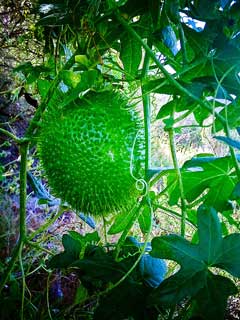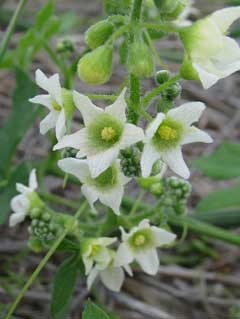 |
|
http://www.flickr.com/photos/emmvl/ |
 |
| http://www.flickr.com/photos/73431753@N00/ |
Translate this page:
Summary
Physical Characteristics

 Marah macrocarpus is a PERENNIAL CLIMBER growing to 5 m (16ft 5in) at a fast rate.
Marah macrocarpus is a PERENNIAL CLIMBER growing to 5 m (16ft 5in) at a fast rate.
See above for USDA hardiness. It is hardy to UK zone 8. It is in flower from July to September. The species is hermaphrodite (has both male and female organs) and is pollinated by Insects. The plant is self-fertile.
Suitable for: light (sandy), medium (loamy) and heavy (clay) soils and prefers well-drained soil. Suitable pH: mildly acid, neutral and basic (mildly alkaline) soils. It cannot grow in the shade. It prefers dry or moist soil.
UK Hardiness Map
US Hardiness Map
Synonyms
Echinocystis macrocarpa. Greene.
Plant Habitats
Woodland Garden Sunny Edge; Dappled Shade;
Edible Uses
References More on Edible Uses
Medicinal Uses
Plants For A Future can not take any responsibility for any adverse effects from the use of plants. Always seek advice from a professional before using a plant medicinally.
Parasiticide Purgative Skin
The root is purgative[61, 257]. The seed is made into a paste and used as a treatment on pimples and skin sores[257]. The oil from the seed is rubbed into the scalp to treat diseased scalps and hair roots[257]. The plant juices can be used as a parasiticide, rubbed onto areas of skin affected by ringworm[257].
References More on Medicinal Uses
The Bookshop: Edible Plant Books
Our Latest books on Perennial Plants For Food Forests and Permaculture Gardens in paperback or digital formats.

Edible Tropical Plants
Food Forest Plants for Hotter Conditions: 250+ Plants For Tropical Food Forests & Permaculture Gardens.
More

Edible Temperate Plants
Plants for Your Food Forest: 500 Plants for Temperate Food Forests & Permaculture Gardens.
More

More Books
PFAF have eight books available in paperback and digital formats. Browse the shop for more information.
Shop Now
Other Uses
Dye Paint Parasiticide Soap
A red dye is obtained from the seed[61]. It can be mixed with iron oxide and turpentine to make a paint[257]. The root is used to make a detergent lather[257].
Special Uses
References More on Other Uses
Cultivation details
Prefers a sunny position in a well-drained rich soil with abundant moisture[1, 175]. Succeeds in ordinary garden soil[175]. Plants are found in dry soils in the wild so this suggests that they will be better off in a dry soil in this country[K]. A perennial plant, it is not very hardy in Britain, tolerating temperatures down to about -5°c, and is perhaps best grown as an annual. A climbing plant, supporting itself by means of tendrils[219].
References Carbon Farming Information and Carbon Sequestration Information
Temperature Converter
Type a value in the Celsius field to convert the value to Fahrenheit:
Fahrenheit:
The PFAF Bookshop
Plants For A Future have a number of books available in paperback and digital form. Book titles include Edible Plants, Edible Perennials, Edible Trees,Edible Shrubs, Woodland Gardening, and Temperate Food Forest Plants. Our new book is Food Forest Plants For Hotter Conditions (Tropical and Sub-Tropical).
Shop Now
Plant Propagation
Seed - sow early spring in pots of rich soil in a greenhouse. Germination usually takes place within 1 - 2 weeks at 20°c. Put 2 or 3 seeds in each pot and thin to the best plant. Grow on fast and plant out after the last expected frosts.
Other Names
If available other names are mentioned here
Native Range
Coming Soon
Weed Potential
Right plant wrong place. We are currently updating this section.
Please note that a plant may be invasive in one area but may not in your area so it's worth checking.
Conservation Status
IUCN Red List of Threatened Plants Status :

Growth: S = slow M = medium F = fast. Soil: L = light (sandy) M = medium H = heavy (clay). pH: A = acid N = neutral B = basic (alkaline). Shade: F = full shade S = semi-shade N = no shade. Moisture: D = dry M = Moist We = wet Wa = water.
Now available:
Food Forest Plants for Mediterranean Conditions
350+ Perennial Plants For Mediterranean and Drier Food Forests and Permaculture Gardens.
[Paperback and eBook]
This is the third in Plants For A Future's series of plant guides for food forests tailored to
specific climate zones. Following volumes on temperate and tropical ecosystems, this book focuses
on species suited to Mediterranean conditions—regions with hot, dry summers and cool, wet winters,
often facing the added challenge of climate change.
Read More
Expert comment
Author
(Greene.)Greene.
Botanical References
71200
Links / References
For a list of references used on this page please go here
Readers comment
© 2010, Plants For A Future. Plants For A Future is a charitable company limited by guarantee, registered in England and Wales. Charity No. 1057719, Company No. 3204567.